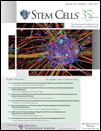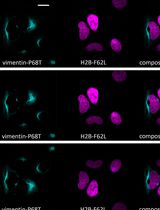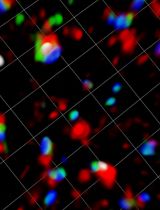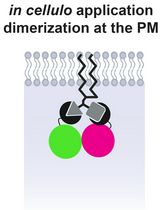- EN - English
- CN - 中文
Analysis of Exosome Transfer in Mammalian Cells by Fluorescence Recovery after Photobleaching
光漂白后荧光恢复技术分析哺乳动物细胞外泌体转移
发布: 2018年01月20日第8卷第2期 DOI: 10.21769/BioProtoc.2692 浏览次数: 8047
评审: Giusy TornilloShuhei OtaAnonymous reviewer(s)
Abstract
During the course of evolution, prokaryote and eukaryote cells have developed elegant and to some extent analogous strategies to communicate with each other and to adapt to their surrounding environment. Eukaryotic cells communicate with each other through direct interaction via juxtracrine signaling and/or by secreting soluble factors. These secreted factors can subsequently act on the cell itself (autocrine signaling) or interact with neighboring (paracrine signaling) and distant (endocrine signaling) cells. The transmission of signals between cells and tissues has been traditionally thought to be regulated by a protein-based signaling system. Typically, proteins destined for secretion into the extracellular milieu by exocytosis contain a canonical secretion-targeting sequence (Théry et al., 2002). However, proteins with a non-continuous and stimulus-dependent secretion, proteins that do not contain a canonical secretion-targeting sequence, and species that might be too labile within the extracellular environment (DNA, mRNA, peptides, metabolites, miRNA and other RNA species), can be secreted in small membranous extracellular vesicles (EVs) in a specific manner (Hagiwara et al., 2014). Exosomes represent one broad class of these secreted membrane vesicles with a diameter of 30-130 nm (Cocucci et al., 2009; Théry et al., 2009; Kowal et al., 2014), which are formed inside the secreting cells in endosomal compartments called multivesicular bodies. Molecules loaded into exosomes as well as the intensity of the exosome transfer between cells are important parameters for the subsequent conditioning of recipient cells. Current knowledge on secretion of exosomes and their internalization in recipient cells remains incomplete. It is known that secretion intensity of exosomes varies according to the cellular type and its physiological state (Garcia et al., 2016). Moreover, the different combination of transmembrane proteins on the surface of exosomes that facilitate the adhesion to the cell-extracellular matrix vary the avidity with which a recipient cell captures exosomes (Hoshino et al., 2015). Here, we have developed an in vitro system by which the transfer of exosomes between cells in co-culture can be quantified using FRAP (‘Fluorescence Recovery After Photobleaching’) technology. This protocol has been used to analyze the effects of exosome transfer of hypoxia inducible factor 1-α (HIF-1α) in Mesenchymal Stem Cells (MSC; HIF-MSC) to Human Umbilical Cord Vein Endothelial Cells (HUVEC) (Gonzalez-King et al., 2017).
Keywords: Exosomes (外泌体)Background
Exosomes are small lipid bilayer vesicles that function as intercellular messengers. Here we created transgenic mesenchymal stem cell (MSC) lines that express the tetraspanin CD63 exosomal marker fused with Red Fluorescent Protein (RFP) to trace and quantify exosome transfer to Human Umbilical Cord Vein Endothelial Cells (HUVECs) using Fluorescence Recovery After Photobleaching (FRAP) technology. This simple method requires an optical microscope, a light source, and a fluorescent probe. As a first step, a background image of the HUVEC is saved before photobleaching. Next, the light source is focused on the HUVEC, and the RFP fluorophores in this region receive high intensity illumination, which causes their fluorescence lifetime to decrease quickly. Using this approach, red fluorescence recovery would be due to exosome uptake by the photobleached HUVEC. We used this system to examine the exosomal transfer of HIF-MSC to HUVEC as a potential therapeutic approach for angiogenesis.
Materials and Reagents
- Pipette tips (SARSTEDT)
- 0.45 μm sterilize filter filtropur (SARSTEDT, catalog number: 83.1823.100 )
- 25-mm glass coverslips (Thermo Scientific, Menzel-Gläser, Braunscheig, Germany)
- 6-well plates (SARSTEDT, catalog number: 83.3920 )
- Culture-Insert 2-well in μ-dish 35 mm, high ibiTreat: ready to use (IBIDI, catalog number: 81176 )
- Sterile individually packaged 5 ml pipettes (SARSTEDT, catalog number: 86.1253.001 )
- 0.22 μm sterilize filter filtropur (SARSTEDT, catalog number: 83.1826.001 )
- 20 ml syringe (B. Braun Medical, catalog number: 4617207V-02 )
- 50 ml corning tube (SARSTEDT, catalog number: 62.547.254 )
- 15 ml conical tubes (SARSTEDT, catalog number: 62.554.502 )
- Human mesenchymal stem cells from dental pulp
- pCT-CD63-RFP lentiviral vector (System Biosciences, catalog number: CYTO120R-VA-1 )
- HEK293T cells
- Absolute ethanol for analysis (Merck, catalog number: 1009832500 )
- Trypan blue (Thermo Fisher Scientific, GibcoTM, catalog number: 15250061 )
- Trypsin/EDTA (Thermo Fisher Scientific, GibcoTM, catalog number: 15400054 )
- DMEM (Thermo Fisher Scientific, GibcoTM, catalog number: 31885023 )
- Heat inactivated FBS (fetal bovine serum) (Thermo Fisher Scientific, GibcoTM, catalog number: 12484028 )
- Penicillin-streptomycin (Thermo Fisher Scientific, GibcoTM, catalog number: 15140122 )
- EGM-2 Bullet Kit (Lonza, catalog number: CC-3162 )
- Puromycin (Sigma-Aldrich, catalog number: P9620 )
- Sodium chloride (NaCl) (Sigma-Aldrich, catalog number: S3014 )
- Potassium chloride (KCl) (Merck, catalog number: PX1405 )
- Potassium phosphate monobasic (KH2PO4) (Sigma-Aldrich, catalog number: P5655 )
- MSC, HIF-MSC and HEK293T culture medium (see Recipes)
- MSC-CD63-RFP and HIF-MSC-CD63-RFP selection medium (see Recipes)
Equipment
- Pipettes (Eppendorf)
- Cell culture hood (any brand)
- Class II Type A2 biological safety hood (any brand)
- Centrifuge (Centrifuge 5804R) (Eppendorf, model: 5804 R )
- Leica TCS SP2 AOBS inverted laser scanning confocal microscope (Leica Microsystems, Heidelberg GmbH, Mnnheim, Germany, http://www.leica-microsystems.com)
- Heating apparatus
Software
- LAS X with FRAP wizard
- ImageJ (https://imagej.softonic.com/descargar?ex=DSK-309.1)
Procedure
文章信息
版权信息
© 2018 The Authors; exclusive licensee Bio-protocol LLC.
如何引用
González-King, H., García, N. A., Ciria, M., Gascón, S. T., Sánchez, R. S., Grueso, H., Gómez, M., Cabezuelo, R. M., Cava, V. L. and Sepúlveda, P. (2018). Analysis of Exosome Transfer in Mammalian Cells by Fluorescence Recovery after Photobleaching. Bio-protocol 8(2): e2692. DOI: 10.21769/BioProtoc.2692.
分类
细胞生物学 > 细胞成像 > 荧光
细胞生物学 > 细胞成像 > 活细胞成像
您对这篇实验方法有问题吗?
在此处发布您的问题,我们将邀请本文作者来回答。同时,我们会将您的问题发布到Bio-protocol Exchange,以便寻求社区成员的帮助。
提问指南
+ 问题描述
写下详细的问题描述,包括所有有助于他人回答您问题的信息(例如实验过程、条件和相关图像等)。
Share
Bluesky
X
Copy link














